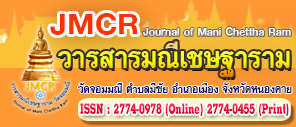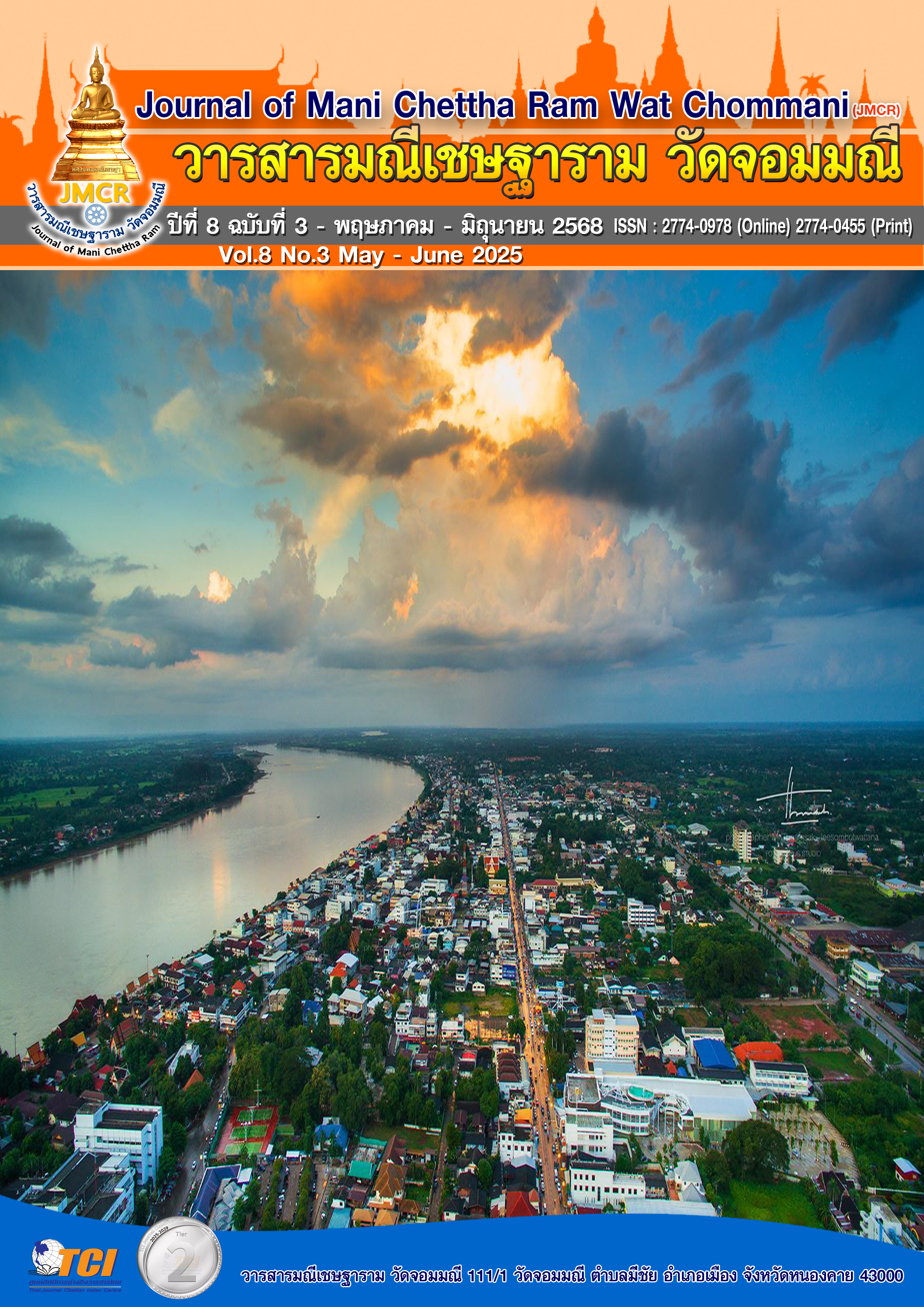THE LEARNING ACTIVITIES ACCORDING TO THE CONCEPT OF STEM THAT PROMOTES, GEOMETRIC THINKING AND MATHEMATICS ACHIEVEMENT FOR MATHAYOMSUKSA 1 STUDENTS
Keywords:
The organization of learning activities based on the STEM education approach, academic achievement, geometric thinkingAbstract
The purposes of this research were (1) Development of Learning Activities Based on STEM Education to Promote Geometric Thinking and Mathematics Achievement for Mathayomsuksa 1 Students to Meet the Efficiency Criterion of 70/70, (2) Comparison of Geometric Thinking and Mathematics Achievement with the 70 percent Criterion, (3) compare learning achievement and aGeometric Thinking before and after instruction, and (4) to examine the satisfaction of Mathayomsuksa 1 students with the implementation of STEM-based learning activities, the sample group consisted of 40 Mathayomsuksa 1 students selected by cluster random sampling. The research instruments included. 1) Lesson plans on geometric constructions based on the STEM education approach, 2) Geometric thinking test, 3) Mathematics achievement test, 4) Student satisfaction questionnaire on learning activities. The statistical methods used for data analysis included percentage, mean, and standard deviation. Using Task Analysis, Analytic Description, and t-tests.
The results showed that 1) The implementation of learning activities achieved an effectiveness of 79.85/75.94, which is higher than the established 70/70 criterion, 2) Geometric thinking had an average score of 15.18, and mathematics achievement had an average score of 15.20, both exceeding the 70% criterion with statistically significant differences at the .05 level, 3) Geometric thinking and mathematics achievement after the learning activities were significantly higher than before the instruction, with statistical significance at the .05 level, 4) After participating in STEM-based learning activities, students expressed high satisfaction, with an average score of 4.64, which falls within the range of 3.51–4.50, indicating a high level of satisfaction.
References
เจนสมุทร แสงพันธ์ และอัญชลี ตานนท์. (2563). การเรียนรู้วิธีการสอนของนักศึกษาครูคณิตศาสตร์ ในการพัฒนาการคิดทางเรขาคณิตของนักเรียนในชั้นเรียนที่ใช้การศึกษาชั้นเรียนและวิธีการแบบเปิด. วารสารมหาวิทยาลัยศิลปากร, 40(1), 138-154.
ชัชวาล อ่อนเกษ และนวพล นนทภา. (2565). การพัฒนาการจัดการเรียนรู้ตามแนวคิดสะเต็มศึกษา เพื่อส่งเสริมความสามารถในการสร้างตัวแบบเชิงคณิตศาสตร์ ของนักเรียนชั้นมัธยมศึกษาปีที่ 3. ใน วิทยานิพนธ์ปริญญาครุศาสตรมหาบัณฑิต. มหาวิทยาลัยราชฏัชมหาสารคาม.
บดีศร อนุชาติ และรามนรี นนทภา. (2566). การจัดกิจกรรมการเรียนรู้แบบกลุ่มร่วมมือร่วมกับโปรแกรม GeoGebra ที่ส่งเสริมการคิดเชิงพีชคณิตและระดับการคิดทางเรขาคณิต. วารสารสหวิชาการวิจัยและวิชาการ, 3(5), 131-134.
บุญชม ศรีสะอาด. (2556). การวิจัยเบื้องต้น. (พิมพ์ครั้งที่ 9). กรุงเทพมหานคร: สุวีริยาสาส์น.
ปรัชญา กุยแก้วพะเนา และนวพล นนทภา. (2565). การพัฒนากิจกรรมการเรียนรู้โดยใช้ปัญหาเป็นฐานร่วมกับแนวคิดสะเต็มศึกษา สำหรับนักเรียนชั้นมัธยมศึกษาปีที่ 6. ใน วิทยานิพนธ์ปริญญาครุศาสตรมหาบัณฑิต. มหาวิทยาลัยราชฏัชมหาสารคาม.
เพียงขวัญ แสนมณี และนวพล นนทภา. (2563). การศึกษาสมรรถนะทางคณิตศาสตร์ โดยใช้รูปแบบการจัดการเรียนรู้แบบโครงงานตามแนวคิดสะเต็มศึกษา ของนักเรียนชั้นประถมศึกษาตอนปลาย.ใน วิทยานิพนธ์ปริญญาครุศาสตรมหาบัณฑิต. มหาวิทยาลัยราชฏัชมหาสารคาม.
ศุภชัย สุนทรชัย. (2024). การศึกษาระดับความคิดทางเรขาคณิตตามแนวคิดของแวนฮีลี เรื่องรูปหลายเหลี่ยมของนักเรียนชั้นประถมศึกษาปีที่ 6: A study of geometric thinking levels about polygons based on the Van Hiele model for 6th grade students. เรียกใช้เมื่อ 1 กุมภาพันธ์ 2568 จาก https://ph02.tcithaijo.org/index.php/withayajarnjournal/article/view/253466.
สำนักวิชาการและมาตรฐานการศึกษา. (2560). หลักสูตรแกนกลางการศึกษาขั้นพื้นฐาน พุทธศักราช 2551 (ฉบับปรับปรุง พุทธศักราช 2560). (พิมพ์ครั้งที่ 1). กรุงเทพฯ: โรงพิมพ์ชุมชนสหกรณ์การเกษตรแห่งประเทศไทยจำกัด.
สิริพร ทิพย์คง. (2532). แวนฮีดี โมเคล: ลำดับขั้นตอนการเรียนรู้เรขาคณิต. วารสารศึกษาศาสตร์ปริทัศน์, 5(3), 91-98.
Seah, R., Horne, M., and Berenger, A. (2016). High school students' knowledge of a square as basis for developing a geometric learning progression. Opening up mathematics education research (Proceedings of the 39th annual conference of the Mathematics Education Research Group of Australasia). Adelaide: MERGA.
Trimurtini, W., Waluya, S. B., Sukestiyarno, Y. L., & Kharisudin, I. (2022). A systematic review on geometric thinking: A review research between 2017-2021. European Journal of Educational Research, 11(3), 1535-1552.
Mehalik, M. M., Doppelt, Y., & Schunn, C. D. (2005). Engagement and Achievements: A Case Study of Design-Based Learning in a Science Context. National Association of Research in Science Teaching (NARST), Dallas, TX. OECD. (2008). Lifelong Learning. OECD Publications.




